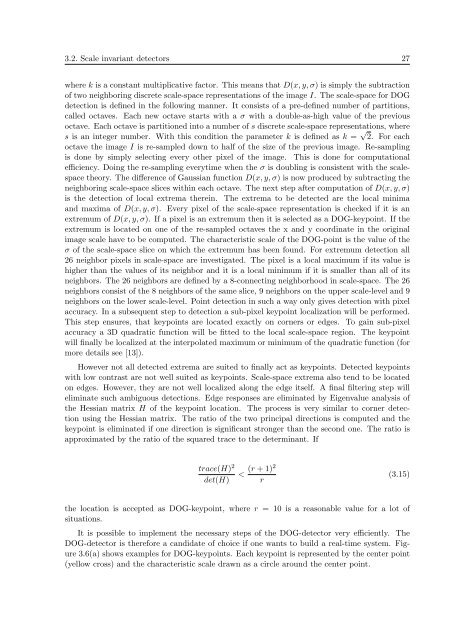PHD Thesis - Institute for Computer Graphics and Vision - Graz ...
PHD Thesis - Institute for Computer Graphics and Vision - Graz ...
PHD Thesis - Institute for Computer Graphics and Vision - Graz ...
Create successful ePaper yourself
Turn your PDF publications into a flip-book with our unique Google optimized e-Paper software.
3.2. Scale invariant detectors 27<br />
where k is a constant multiplicative factor. This means that D(x, y, σ) is simply the subtraction<br />
of two neighboring discrete scale-space representations of the image I. The scale-space <strong>for</strong> DOG<br />
detection is defined in the following manner. It consists of a pre-defined number of partitions,<br />
called octaves. Each new octave starts with a σ with a double-as-high value of the previous<br />
octave. Each octave is partitioned into a number of s discrete scale-space representations, where<br />
s is an integer number. With this condition the parameter k is defined as k = √ 2. For each<br />
octave the image I is re-sampled down to half of the size of the previous image. Re-sampling<br />
is done by simply selecting every other pixel of the image. This is done <strong>for</strong> computational<br />
efficiency. Doing the re-sampling everytime when the σ is doubling is consistent with the scalespace<br />
theory. The difference of Gaussian function D(x, y, σ) is now produced by subtracting the<br />
neighboring scale-space slices within each octave. The next step after computation of D(x, y, σ)<br />
is the detection of local extrema therein. The extrema to be detected are the local minima<br />
<strong>and</strong> maxima of D(x, y, σ). Every pixel of the scale-space representation is checked if it is an<br />
extremum of D(x, y, σ). If a pixel is an extremum then it is selected as a DOG-keypoint. If the<br />
extremum is located on one of the re-sampled octaves the x <strong>and</strong> y coordinate in the original<br />
image scale have to be computed. The characteristic scale of the DOG-point is the value of the<br />
σ of the scale-space slice on which the extremum has been found. For extremum detection all<br />
26 neighbor pixels in scale-space are investigated. The pixel is a local maximum if its value is<br />
higher than the values of its neighbor <strong>and</strong> it is a local minimum if it is smaller than all of its<br />
neighbors. The 26 neighbors are defined by a 8-connecting neighborhood in scale-space. The 26<br />
neighbors consist of the 8 neighbors of the same slice, 9 neighbors on the upper scale-level <strong>and</strong> 9<br />
neighbors on the lower scale-level. Point detection in such a way only gives detection with pixel<br />
accuracy. In a subsequent step to detection a sub-pixel keypoint localization will be per<strong>for</strong>med.<br />
This step ensures, that keypoints are located exactly on corners or edges. To gain sub-pixel<br />
accuracy a 3D quadratic function will be fitted to the local scale-space region. The keypoint<br />
will finally be localized at the interpolated maximum or minimum of the quadratic function (<strong>for</strong><br />
more details see [13]).<br />
However not all detected extrema are suited to finally act as keypoints. Detected keypoints<br />
with low contrast are not well suited as keypoints. Scale-space extrema also tend to be located<br />
on edges. However, they are not well localized along the edge itself. A final filtering step will<br />
eliminate such ambiguous detections. Edge responses are eliminated by Eigenvalue analysis of<br />
the Hessian matrix H of the keypoint location. The process is very similar to corner detection<br />
using the Hessian matrix. The ratio of the two principal directions is computed <strong>and</strong> the<br />
keypoint is eliminated if one direction is significant stronger than the second one. The ratio is<br />
approximated by the ratio of the squared trace to the determinant. If<br />
trace(H) 2<br />
det(H)<br />
<<br />
(r + 1)2<br />
r<br />
(3.15)<br />
the location is accepted as DOG-keypoint, where r = 10 is a reasonable value <strong>for</strong> a lot of<br />
situations.<br />
It is possible to implement the necessary steps of the DOG-detector very efficiently. The<br />
DOG-detector is there<strong>for</strong>e a c<strong>and</strong>idate of choice if one wants to build a real-time system. Figure<br />
3.6(a) shows examples <strong>for</strong> DOG-keypoints. Each keypoint is represented by the center point<br />
(yellow cross) <strong>and</strong> the characteristic scale drawn as a circle around the center point.















